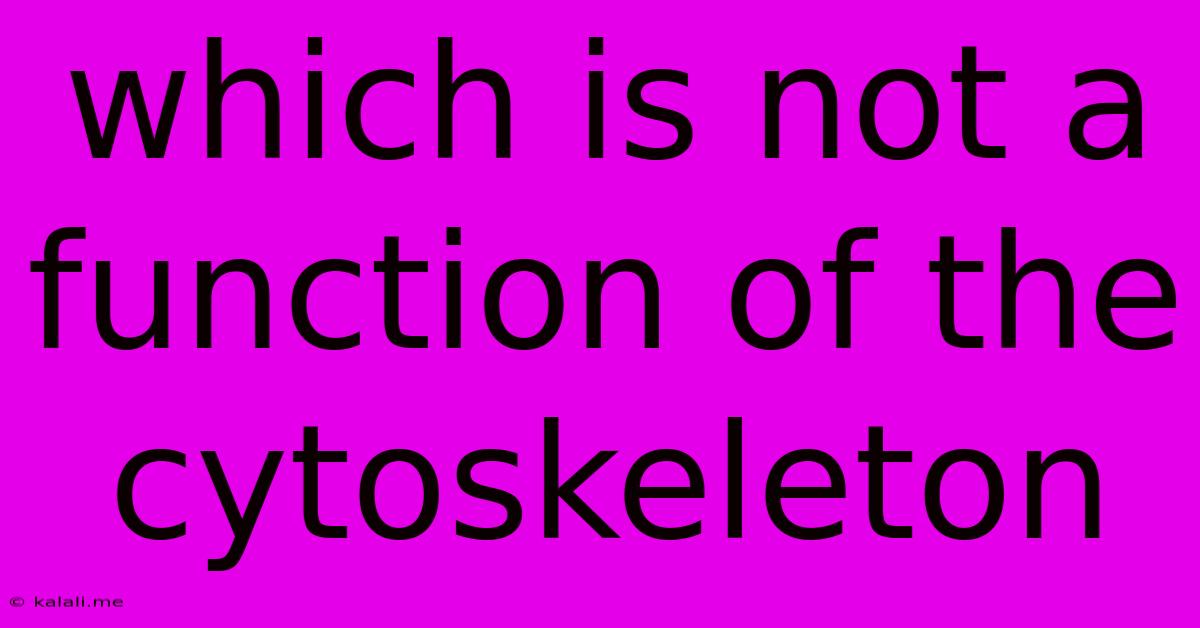Which Is Not A Function Of The Cytoskeleton
Kalali
Jun 14, 2025 · 3 min read

Table of Contents
Which is NOT a Function of the Cytoskeleton? Understanding the Cell's Internal Framework
The cytoskeleton, a complex network of protein filaments within a cell, plays a crucial role in maintaining cell shape, facilitating intracellular transport, and enabling cell movement. But what exactly doesn't the cytoskeleton do? This article explores the key functions of the cytoskeleton and highlights activities that fall outside its purview. Understanding these limitations is essential for a complete grasp of cellular biology.
Key Functions of the Cytoskeleton:
The cytoskeleton isn't a static structure; it's a dynamic system constantly assembling and disassembling to meet the cell's needs. Its primary functions include:
-
Maintaining Cell Shape and Structure: Think of the cytoskeleton as the cell's internal scaffolding. It provides structural support, preventing the cell from collapsing or becoming misshapen. This is particularly important for cells lacking rigid cell walls, like animal cells.
-
Intracellular Transport: Motor proteins, like kinesin and dynein, "walk" along cytoskeletal filaments, carrying organelles, vesicles (containing proteins and other molecules), and other cargo to their destinations within the cell. This efficient transport system is vital for cell function.
-
Cell Movement: The cytoskeleton is instrumental in various types of cell movement, including cell crawling (amoeboid movement), cilia and flagella beating, and cytokinesis (cell division). Different cytoskeletal components contribute to these diverse movements.
-
Cell Signaling: The cytoskeleton plays a role in cell signaling by influencing the location and organization of signaling molecules. It also contributes to the formation of cell junctions, facilitating communication between cells.
-
Chromosome Segregation: During cell division, the cytoskeleton plays a critical role in segregating chromosomes accurately to daughter cells, ensuring genetic continuity.
What the Cytoskeleton DOES NOT Do:
While the cytoskeleton's influence is extensive, there are certain cellular processes it doesn't directly participate in. These include:
-
Protein Synthesis: The ribosomes, located in the cytoplasm or attached to the endoplasmic reticulum, are responsible for protein synthesis, not the cytoskeleton. The cytoskeleton may indirectly influence protein synthesis by transporting mRNA to ribosomes or affecting the location of ribosomes. However, it doesn't directly catalyze the formation of peptide bonds.
-
DNA Replication: DNA replication is a complex process carried out by enzymes like DNA polymerase and helicase. These enzymes work in the nucleus, while the cytoskeleton primarily resides in the cytoplasm. While the cytoskeleton might support the structural integrity of the nucleus, it doesn't directly participate in DNA replication mechanisms.
-
Gene Transcription: Transcription, the process of creating RNA from DNA, occurs within the nucleus and involves RNA polymerase and other transcription factors. The cytoskeleton doesn't directly participate in this process, although its role in nuclear shape and organization might have an indirect influence.
-
Direct Energy Production: While the cytoskeleton indirectly impacts cellular processes that generate energy (e.g., by transporting mitochondria), it doesn't directly produce ATP (adenosine triphosphate), the cell's primary energy currency. Mitochondria and other cellular components are responsible for energy production.
Conclusion:
The cytoskeleton is a dynamic and essential cellular component with diverse functions vital for cell survival and function. However, it's crucial to understand its limitations. It doesn't directly participate in processes such as protein synthesis, DNA replication, gene transcription, or direct energy production. These activities are handled by other specialized cellular machinery. A comprehensive understanding of both the cytoskeleton's roles and limitations provides a more accurate and complete picture of cellular biology.
Latest Posts
Latest Posts
-
What Is The Lcm Of 24 And 14
Jun 15, 2025
-
Mass Of A Proton In Mev
Jun 15, 2025
-
What Is An Ion With A Positive Charge Called
Jun 15, 2025
-
What Is Resolution Of A Measuring Instrument
Jun 15, 2025
-
Extracellular Fluid Is Found Everywhere In The Body Except
Jun 15, 2025
Related Post
Thank you for visiting our website which covers about Which Is Not A Function Of The Cytoskeleton . We hope the information provided has been useful to you. Feel free to contact us if you have any questions or need further assistance. See you next time and don't miss to bookmark.